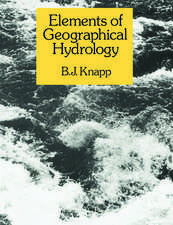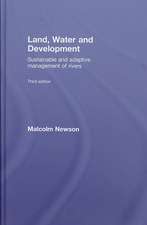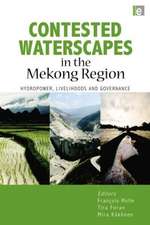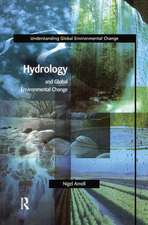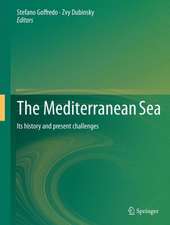Catchment and River Basin Management: Integrating Science and Governance: Earthscan Studies in Water Resource Management
Editat de Laurence Smith, Keith Porter, Kevin Hiscock, Mary Jane Porter, David Bensonen Limba Engleză Hardback – 23 apr 2015
A final synthesis presents a set of principles for adaptive catchment management. These principles demonstrate how to integrate the best scientific and technical knowledge with policy, governance and legal provisions. It is shown how decision-making and implementation at the appropriate geographic and governmental scales can resolve conflicts and share best sustainable practices.
| Toate formatele și edițiile | Preț | Express |
|---|---|---|
| Paperback (1) | 449.41 lei 6-8 săpt. | |
| Taylor & Francis – 14 iun 2017 | 449.41 lei 6-8 săpt. | |
| Hardback (1) | 1060.25 lei 6-8 săpt. | |
| Taylor & Francis – 23 apr 2015 | 1060.25 lei 6-8 săpt. |
Din seria Earthscan Studies in Water Resource Management
-
 Preț: 378.67 lei
Preț: 378.67 lei -
 Preț: 326.49 lei
Preț: 326.49 lei -
 Preț: 311.39 lei
Preț: 311.39 lei -
 Preț: 155.44 lei
Preț: 155.44 lei - 8%
 Preț: 389.10 lei
Preț: 389.10 lei -
 Preț: 310.12 lei
Preț: 310.12 lei -
 Preț: 256.04 lei
Preț: 256.04 lei -
 Preț: 312.20 lei
Preț: 312.20 lei -
 Preț: 279.32 lei
Preț: 279.32 lei -
 Preț: 326.26 lei
Preț: 326.26 lei -
 Preț: 470.90 lei
Preț: 470.90 lei - 18%
 Preț: 1060.25 lei
Preț: 1060.25 lei -
 Preț: 491.82 lei
Preț: 491.82 lei - 10%
 Preț: 311.38 lei
Preț: 311.38 lei - 18%
 Preț: 1000.27 lei
Preț: 1000.27 lei -
 Preț: 479.19 lei
Preț: 479.19 lei -
 Preț: 442.68 lei
Preț: 442.68 lei - 18%
 Preț: 1000.27 lei
Preț: 1000.27 lei - 18%
 Preț: 1056.32 lei
Preț: 1056.32 lei - 18%
 Preț: 1054.71 lei
Preț: 1054.71 lei - 18%
 Preț: 1064.70 lei
Preț: 1064.70 lei - 18%
 Preț: 1001.84 lei
Preț: 1001.84 lei - 18%
 Preț: 1052.38 lei
Preț: 1052.38 lei - 25%
 Preț: 767.07 lei
Preț: 767.07 lei - 18%
 Preț: 1003.93 lei
Preț: 1003.93 lei - 18%
 Preț: 1056.00 lei
Preț: 1056.00 lei -
 Preț: 469.34 lei
Preț: 469.34 lei - 18%
 Preț: 1173.90 lei
Preț: 1173.90 lei -
 Preț: 485.46 lei
Preț: 485.46 lei - 18%
 Preț: 1009.74 lei
Preț: 1009.74 lei - 31%
 Preț: 763.23 lei
Preț: 763.23 lei - 31%
 Preț: 764.22 lei
Preț: 764.22 lei - 12%
 Preț: 312.43 lei
Preț: 312.43 lei - 18%
 Preț: 730.71 lei
Preț: 730.71 lei - 12%
 Preț: 325.34 lei
Preț: 325.34 lei - 31%
 Preț: 765.36 lei
Preț: 765.36 lei -
 Preț: 409.31 lei
Preț: 409.31 lei -
 Preț: 416.22 lei
Preț: 416.22 lei -
 Preț: 483.49 lei
Preț: 483.49 lei - 18%
 Preț: 1001.84 lei
Preț: 1001.84 lei
Preț: 1060.25 lei
Preț vechi: 1292.98 lei
-18% Nou
Puncte Express: 1590
Preț estimativ în valută:
202.91€ • 211.05$ • 167.51£
202.91€ • 211.05$ • 167.51£
Carte tipărită la comandă
Livrare economică 15-29 aprilie
Preluare comenzi: 021 569.72.76
Specificații
ISBN-13: 9781849713047
ISBN-10: 1849713049
Pagini: 310
Ilustrații: 8 black & white illustrations, 7 colour illustrations, 3 black & white tables, 5 black & white line drawings, 7 colour line drawings
Dimensiuni: 156 x 234 x 23 mm
Greutate: 0.61 kg
Ediția:New.
Editura: Taylor & Francis
Colecția Routledge
Seria Earthscan Studies in Water Resource Management
Locul publicării:Oxford, United Kingdom
ISBN-10: 1849713049
Pagini: 310
Ilustrații: 8 black & white illustrations, 7 colour illustrations, 3 black & white tables, 5 black & white line drawings, 7 colour line drawings
Dimensiuni: 156 x 234 x 23 mm
Greutate: 0.61 kg
Ediția:New.
Editura: Taylor & Francis
Colecția Routledge
Seria Earthscan Studies in Water Resource Management
Locul publicării:Oxford, United Kingdom
Public țintă
PostgraduateCuprins
Foreword Philip Lowe, Director, Rural Economy and Land Use Programme Part 1: Overview 1. The Challenge of Protecting Water Resources: an Introduction and the Purposes of this Book Laurence Smith, Keith Porter, Kevin Hiscock, David Benson and Mary Jane Porter 2. Key Questions about Catchment Management Laurence Smith, David Benson and Keith Porter Part 2: Case Studies 3. The Upper Susquehanna River Basin: Headwaters of a National Treasure – The Chesapeake Bay Mary Jane Porter, Keith Porter, James Curatolo, Mike Lovegreen and Laurence Smith 4. New York City Watershed Program: A National Paradigm? Keith Porter and Laurence Smith 5. The Hudson River Watershed, New York State, USA Mary Jane Porter, Keith Porter and Laurence Smith 6. Healthy Waterways, South East Queensland, Australia Laurence Smith, David Benson and Diane Tarte 7. Groundwater Protection Programmes in Denmark, Germany and the Netherlands Laurence Smith, David Benson and Kevin Hiscock 8. The WWF RIPPLE Project (Rivers Involving People, Places and Leading by Example), Ulster, Northern Ireland Alex Inman and Mark Horton 9. Opening up Catchment Science: an Experiment in Loweswater, Cumbria, England Claire Waterton, Stephen C. Maberly, Lisa Norton, Judith Tsouvalis, Nigel Watson, and Ian J. Winfield Part 3: Lessons for Catchment and River Basin Management 10. Getting Started: Partnerships, Collaboration, Participation and the Role of Law Laurence Smith, Keith Porter and David Benson 11. Getting Informed: Tools and Approaches for Assessment, Planning and Management Laurence Smith, Kevin Hiscock, Keith Porter, Tobias Krueger and David Benson 12. Getting Things Done and Getting Results Laurence Smith, Keith Porter and David Benson 13. Conclusions and Future Challenges Laurence Smith, Keith Porter, David Benson and Kevin Hiscock
Notă biografică
Laurence Smith is Professor of Environmental Policy and Development in the Centre for Development, Environment and Policy, SOAS, University of London, UK.
Keith Porter is Adjunct Professor at Cornell Law School and the former Director of the New York State Water Resources Institute, Cornell University, Ithaca, USA.
Kevin Hiscock is Professor of Environmental Sciences, University of East Anglia, UK.
Mary Jane Porter is recently retired from the New York State Water Resources Institute, Cornell University, USA.
David Benson is Lecturer in Politics at the University of Exeter, UK, based at the Environment and Sustainability Institute (ESI) in Penryn, Cornwall.
Keith Porter is Adjunct Professor at Cornell Law School and the former Director of the New York State Water Resources Institute, Cornell University, Ithaca, USA.
Kevin Hiscock is Professor of Environmental Sciences, University of East Anglia, UK.
Mary Jane Porter is recently retired from the New York State Water Resources Institute, Cornell University, USA.
David Benson is Lecturer in Politics at the University of Exeter, UK, based at the Environment and Sustainability Institute (ESI) in Penryn, Cornwall.
Recenzii
"The authors correctly note that, while people will generally want higher water quality, there are numerous trade-offs that would diminish their willingness to change behaviours that negatively affect water quality and quantity. Water pollution could thus be regarded as a ‘market failure’, requiring intervention by policymakers such as regulation, incentives and voluntary agreements with land users, self-regulation, education campaigns, etc." – African Journal of Aquatic Science, John P Simaika, Stellenbosch University, South Africa
"The book will be particularly useful to those engaged in Catchment Partnerships through Defra's Catchment Based Approach (CaBA) programme, whether in pointing out ways forward or giving confidence that persistence with building communites of practice will gain success in the longer term - anyone strarting in catchment management will soon realise that developments do not happen overnight!" - Bob Harris, Costal Futures
"The book will be particularly useful to those engaged in Catchment Partnerships through Defra's Catchment Based Approach (CaBA) programme, whether in pointing out ways forward or giving confidence that persistence with building communites of practice will gain success in the longer term - anyone strarting in catchment management will soon realise that developments do not happen overnight!" - Bob Harris, Costal Futures
Descriere
The central focus of this book is a critical comparative analysis of the key drivers for water resource management and the provision of clean water - governance systems and institutional and legal arrangements. Through a series of case studies it is shown how decision-making and implementation at the appropriate geographic and governmental scales can resolve conflicts and share best sustainable practices.

